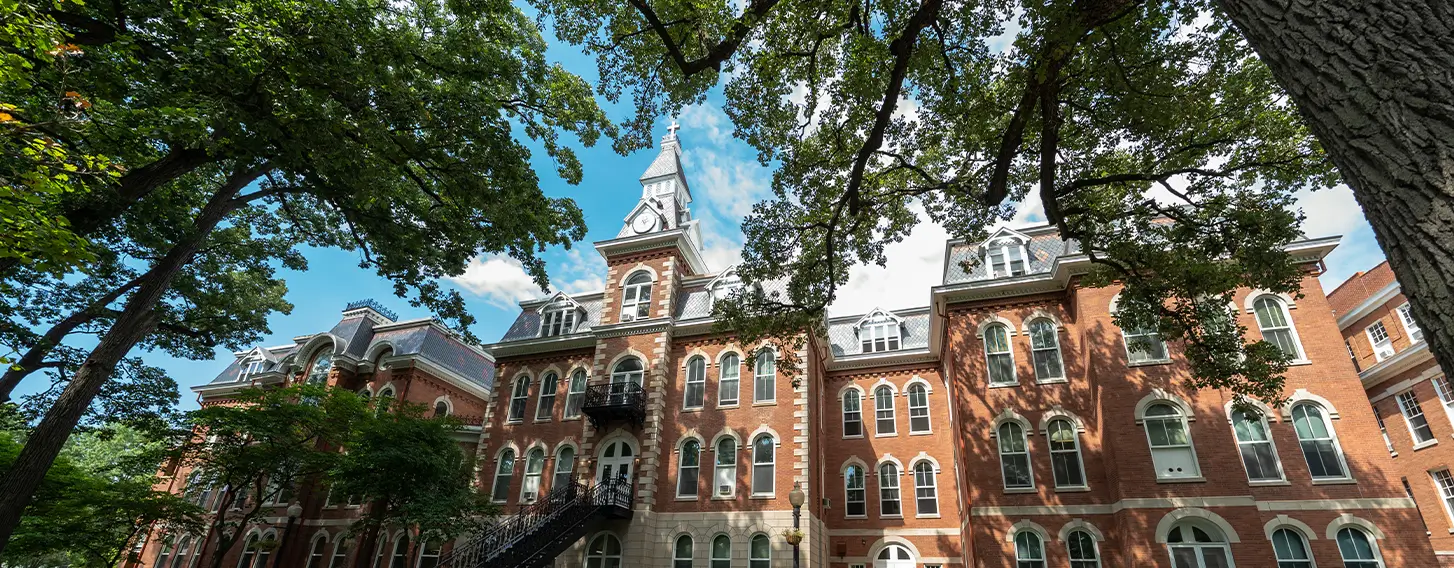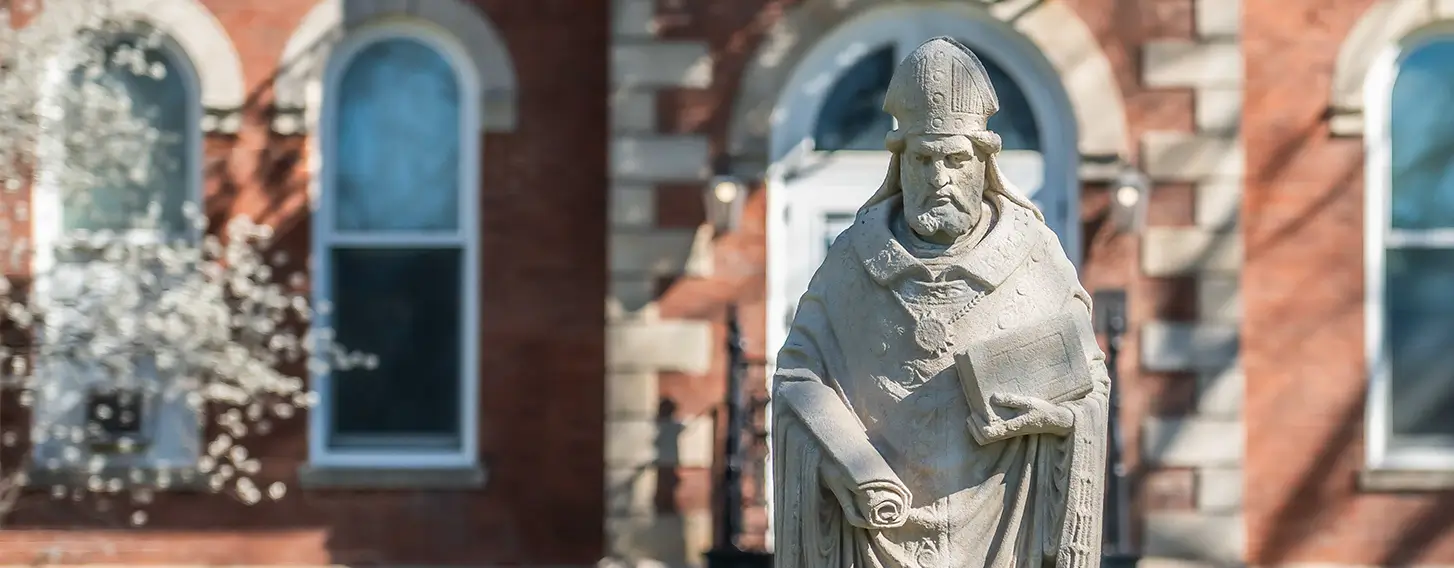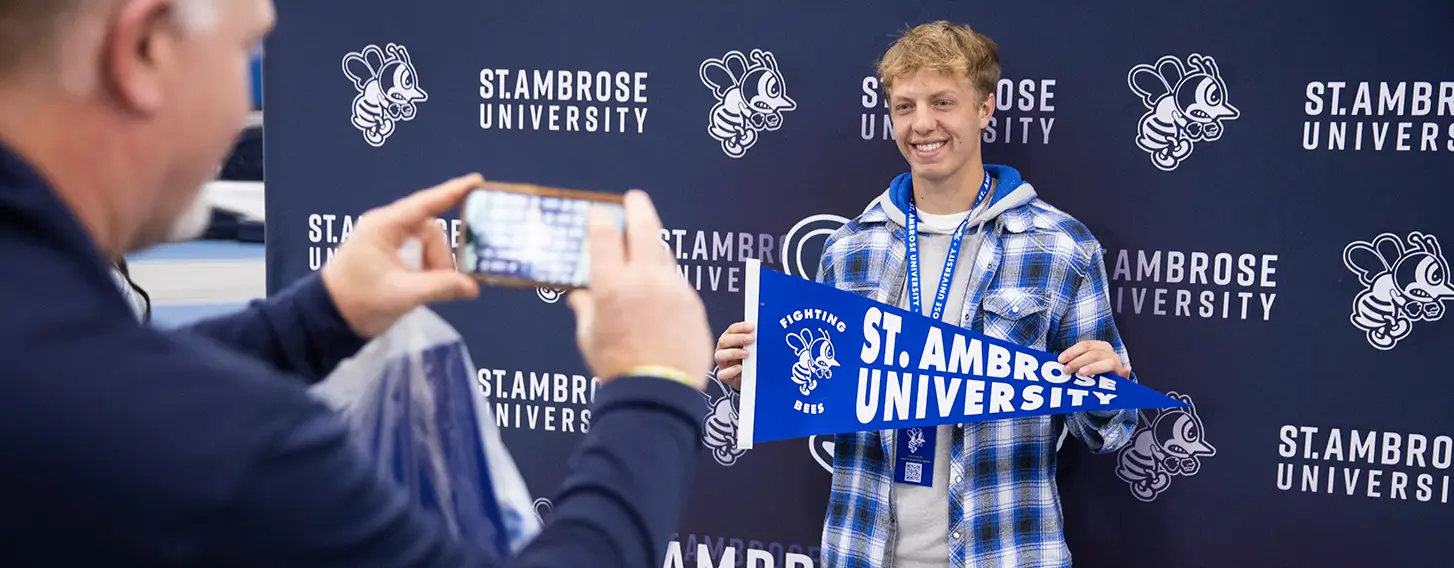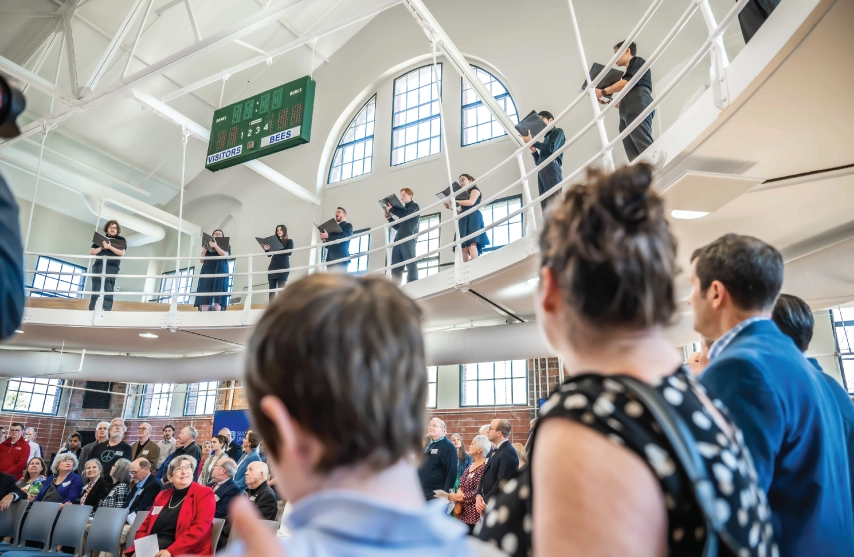

The history of St. Ambrose University is a tapestry where faith, knowledge and service intertwine. This interconnection can still be witnessed every day through our faculty, staff, and students.
St. Ambrose University traces its roots to 1882, when Bishop John McMullen established a seminary in Davenport, Iowa. From humble beginnings in two rooms at St. Marguerite’s School, the institution quickly expanded, moving to its current campus in 1885 and adopting the name “St. Ambrose College” in 1908. With the introduction of night school and summer programs, St. Ambrose continued to broaden its academic offerings, reflecting a commitment to accessible education. In 1987, the institution received university status, which was a testament to its growth and academic vigor. Today, St. Ambrose stands as a vibrant coeducational institution fostering a legacy of learning and academic excellence.
1882: St. Ambrose Seminary/Academy officially opens at St. Marguerite's School, now known as Sacred Heart, with 33 male students ages 12 - 23. Their tuition? A staggering $3 a month.
1883: Bishop John McMullen dies of cancer less than a year after helping found St. Ambrose.
1884: Play ball! A professor returns from dinner one evening with a new baseball bat, marking the beginning of athletics on campus. Although numerous windows were broken, the excitement spurred the forming of two intramural teams, the "Collegians" and the "Metropolitans."
1885: St. Ambrose moves to the oak grove on 10 acres near Scott and Locust Streets. Bishop Cosgrove's first preference for the school was the land around 8th and Ripley Streets.
1885: Judge M.B. Gannon is the speaker at the first recorded commencement. Think the ceremony lasts a long time now? This one went "well into the evening."
1888: Ambrose's second building, "The Play Hall," is built as a gymnasium for indoor games.
1891: Founding faculty member Joseph Halligan leaves Ambrose to found the Davenport Daily Leader newspaper, which runs until June 1903. The publication covers everything from armed mail robberies to theories on Jack the Ripper.
1895: The Saint Ambrose statue arrives on campus from Europe. Over the years, the statue will endure being painted green on St. Patrick's Day and losing a hand in 1936. The official record blames a severe storm for the damage. Rumor has it a student returning from a party climbed the statue to bid it goodnight.
1901: The Rev. Ulrich Hauber, destined to become a nationally recognized biologist, enrolls at St. Ambrose just as physics, geology, botany and astronomy are added to the curriculum. In addition to developing the pre-med program and publishing numerous journals, Hauber became the fifth college president in 1926.
1902: A fire breaks out in President Flannagan's apartment in Ambrose Hall. To preserve the building, students toss his burning couch out the window.
The first record on campus of a bat, St. Ambrose's unofficial mascot, is detailed in a student's journal. The annoyance is removed with a violin bow and hat. Today, these mammals tend to be found in Davis Hall.
1909: The college's first recorded basketball game takes place in the gymnasium against the Augustana Vikings. There's no score recorded for that match-up, but in the coming years the Vikings would regularly trounce the Bees. Sweet revenge? In 1947, the last football brawl between the two ended in a 26-6 win for the Fighting Bees.
1910: Perseverance and prowess are honored as the first varsity letters are awarded in baseball, football, and basketball.
1914: Can you hear me now? The first electronic media, a wireless station, starts on campus. The original range is a meager five miles, but after working on the station for a month, the students pick up signals as far away as Virginia.
1918: A flu epidemic closes the school for six weeks as healthy students are sent home. Correspondence classes are created for day students.
1919: Calling all Bees! The first endowment campaign begins. The goal? To build Davis Hall. A total of $468,000 is pledged from local parishes and the city, but a farm depression means only half the payments are delivered.
1921: Monsignor U.A. Hauber brings the first automobile to campus, although he didn't drive. His experimental voyage to Muscatine for watermelons nearly ends in an accident when none other than a bee flies up his pant leg.
Ground breaks on Davis Hall, the campus's first residence hall. The building is constructed in two parts, half completed in 1922 and half in 1926.
1922: Homecoming traditions begin, with more than 400 alumni in attendance. In addition to a parade, freshmen start gathering firewood at the beginning of the year for the big bonfire. In later years, guards watch around the clock to keep rivals from stealing the wood or burning it.
1927: North Central Association of Colleges accredits St. Ambrose.
1928: The faculty grows to include 15 priests and three lay teachers. Clergy members are required to document the specifics of their absences with the switchboard, including what time they leave, where they go, and what they're doing.
1932: Charles Toney '75 (Hon) becomes the first black student enrolled at St. Ambrose. He worked for 42 years at John Deere where he became the company's first black executive in 1972.
1933: Sister Edith Cane is the first female student to be allowed to reside on campus. To prevent a commute from Ottumwa, Iowa, she is permitted to stay with the college domestic staff.
1934: Construction is completed on the mighty Mississippi's Lock and Dam 15, making it the largest roller dam in the United States.
1935: The first alumni club is formed. No surprise here – the club is based out of Chicago. But do they support the Cubs or the White Sox?
1937: Bishop Rohlman begins the process of acquiring the property for the women's division at Marycrest College. The $50,000 piece of land was eventually donated to the college, which opened in 1939.
1939: With the country in the throes of the Great Depression, St. Ambrose begins the fund drive for a new chapel. Miraculously, the $400,000 goal was met within a month, although construction didn't begin until 1952.
1942: G.I. 'Brose. The college was selected to host a V-12 cadet-training program for the U.S. Navy during World War II. Loras College is also considered, but St. Ambrose wins out because of LeClaire Hall's swimming pool.
1947: The creation of the G.I. Bill attracts more students, and old military barracks are brought to campus for student housing. The barracks remained until 1960, when they were razed to make room for the Galvin Fine Arts Center. A total of 24 Ambrosians gave their lives in the war effort.
The NAACP chapter at Ambrose is formed, becoming the first NAACP chapter on a Catholic campus. Continuing St. Ambrose's social justice tradition, students protest for civil rights and labor issues.
1950’s: Students and faculty lobbied for better living conditions at Cooks Point, a Latino community in Davenport without running water. They even built new homes, complete with plumbing.
1951: St. Ambrose University establishes the League for Social Justice.
1952: Men are from Mars, Women are from Mercy...A partnership with the Mercy Hospital Nursing Program means women can earn a BS in Nursing from St. Ambrose. The female students live at the hospital.
1954: Marycrest is accredited, marking the school's independence from St. Ambrose.
1958: With the opening of Assumption High School, St. Ambrose Academy, the high school on campus long associated with the college, closes.
1959: Big Ten, Big Problem. Ambrose football begins an 18-year hiatus due to financial problems. With the emergence of television, spectators prefer to watch the Big Ten games instead of traveling to the local stadium.
1960: East Hall, now Rohlman, opens. It will come to be known affectionately by its male occupants as "Beast Hall" due to "uncontrollable showers," bare floors, thin walls, and malfunctioning air conditioning, until it undergoes a total renovation in 2001.
1965: Four St. Ambrose students accompanied Rev. Francis Duncan to Selma, Ala., for the March on Montgomery, led by Rev. Martin Luther King Jr.
1965: Mississippi mud. As the river floods, classes are canceled for two-and-a-half days so students can help sandbag. The mayor of Davenport commends the school for saving Davenport Water Works.
1967: Snug as a bug... Hayes Hall is completed for seminary students, though the building is 10 beds short. The faculty apartments are turned into triple rooms to accommodate all the residents.
1968: Ambrose officially becomes co-educational, with men and women taking classes together for the first time. However, the women must commute until 1969 when South Hall (Cosgrove) opens. The catch? The building opens in sections due to a steel workers’ strike that lasts through the summer.
1970: With war protests heating up after the invasion of Cambodia, classes are suspended for the remainder of the academic year to allow students to go home and help protest. President Menke even leads a protest down Locust Street.
1971: The board of directors welcomes its first female member with the election of Margaret Tiedemann.
1972: Close only counts in horseshoes. Details are finalized for Newman College, the proposed name of the merger of Ambrose and Marycrest. The course catalog is partially printed and the inter-campus bus, the Bee Hound, is already transporting students when the deal is nixed.
Bottoms up! After the drinking age is lowered, a campus pub is opened in the Beehive area. Martinis and Manhattans are offered at the Last Class for 55 cents each.
1977: St. Ambrose enters the graduate education arena with the launch of the Master of Business Administration degree program. The program became fully accredited in 1979.
1979: St. Ambrose's own Father Edward Catich, a world-renowned calligrapher and artist, dies of a heart attack in his studio on campus at the age of 73. He leaves a large portion of his collection to John Schmits, professor of art at St. Ambrose, who in turn donates these works to the university to start the Catich Gallery.
1983: The Fighting Bees have a new "hive" to call home with the construction of Lee Lohman Arena. The $3-million project seats 2,200 fans.
1984: Computers make their debut on campus as 12 Apple 2e machines are installed in a "lab." A 25-minute video is produced to explain how to use the computers, which have only word processing capabilities.
Phones are installed in student rooms and the campus gets an ATM machine.
1985: On the rocks...or not. The legal drinking age is raised to 21 years of age, much to the chagrin of underclassmen.
1987: Drumroll, please! Ambrose officially becomes a university.
Edward Rogalski is named the university's 12th president.
Hear ye, hear ye! Oprah Winfrey and U.S. Senator Bob Dole visit campus as speakers. Dole comes in March to discuss his senatorial experience, while Winfrey addresses attendees of the Quad Cities Women's Day Conference at the Galvin Fine Arts Center in April.
1993: The hip bone's connected to the leg bone. Biology at St. Ambrose is taken to a new level as the cadaver lab opens with 18 bodies for anatomy students to examine.
1994: St. Ambrose hops on the information superhighway by providing all students, faculty and staff with e-mail accounts. The university won't develop its website until the following October.
1996: The old library moves from McMullen Hall to the newly constructed library building, with 350 students, faculty and staff lining up to pass part of the collection across campus. The 114 books passed represent each year of St. Ambrose's existence.
Housing, we have a problem. "Residence Row," as it will be dubbed in 2005, begins with the construction of Tiedemann Hall. Hagen Hall followed in 2000, and bookends Bechtel and Franklin were created in 2004 and 2005, respectively.
1997: Somebody call the doctor! Classes start for the Doctor of Business Administration program, the first doctoral program offered at SAU. The Master of Physical Therapy program will be converted to a doctoral program in 2002.
2004: The completion of the Rogalski Center upgrades life on campus with amenities that include a food court, wireless capabilities, and spacious facilities to play games, study or even have student dances!
2005: Franklin Hall opens to complete "Residence Row."
2007: Fondest farewells! President Ed Rogalski retires after 20 years as president. He makes the record book as the longest serving president at a private university in the state of Iowa.
Warmest welcome! Sister Joan Lescinski becomes the 13th president.
2008: St. Ambrose successfully secures unconditional reaccreditation by the Higher Learning Commission for 10 years – the maximum term granted.
A new combined-use academic and residential building, with 11 classrooms and suite-style living space for 96 students, is finished just in time for St. Ambrose to welcome its largest enrollment ever. It was dedicated in August 2013 as McCarthy Hall.
2010: The $11.5 million Center for Health Sciences Education at Genesis opens with generous support from its Health Services Foundation. This building serves as a brand-new home to our growing health services programs.
2010: Alumnus Jim Collins develops the Decade of Diversity, a document to capture pragmatic steps to enhance the St. Ambrose University stated value of diversity.
2012: North Hall, a residence with 204 beds, was built on the northeast corner of Lombard and Harrison streets.
2017: The largest single capital campaign in university history, nearly $18 million, was raised to build a state-of-the-art, 80,000-square-foot Wellness and Recreation Center.
2018: A prayer space in Ambrose Hall was dedicated to honor the sudden passing of Fr. Joseph DeFrancisco, Professor of Theology.
2020: On August 10, a derecho (a widespread, straight-line wind storm) struck the Quad Cities and wiped out power on campus for more than 24 hours.
McMullen Hall reopened in the fall, with a 15,600 square-foot addition made possible by an $8.6 million fundraising campaign. The academic hall houses the College of Business faculty and programs.

Saint Ambrose of Milan, the namesake of our university, epitomized intellectual prowess, compassion, and leadership. His life and teachings inspire us to pursue academic excellence, embrace social justice, and live with integrity. Deeply invested in knowledge and understanding, Saint Ambrose believed education was essential for spiritual and intellectual growth. Empowering students to become community and global leaders, we follow Saint Ambrose’s example, recognizing that true excellence is inseparable from compassion, justice, and the common good.
The mission of the Academy for the Study of Saint Ambrose of Milan (ASSAM) is to promote the study and story of St. Ambrose of Milan, especially at St. Ambrose University, by encouraging and supporting educational programs, research and scholarship, and creative work.

St. Ambrose University has the Fighting Bee as our mascot, which isn’t just coincidence. Bees have a unique connection to the namesake of our university. According to legend, a swarm of bees was discovered covering St. Ambrose’s head as an infant. They didn’t sting him, but dropped a bit of honey into the future saint’s tongue and flew off. This honey was said to foreshadow St. Ambrose’s eventual sweet and eloquent words. The bee is also a symbol of work, creative activity, cooperation, orderliness, and diligence. This is reflected in the drive and tenacity of our university athletic teams during competition.
Explore SAU athletic programs
The St. Ambrose campus was established in a grove of oak trees, of which many still grow all over campus. When members of the alumni association wanted a hymn of praise to St. Ambrose College, the music department chose the melody "Finlandia," by the Finnish composer Jean Sibelius. They held a campus contest to write lyrics, and in May 1937 William Kerrigan, a senior from Davenport, was declared the winner. The rendition of the alma mater below is arranged and performed by William Campbell, PhD, Professor of Music at St. Ambrose University.
Ambrosian oaks what mighty deeds you know!
Our hearts fair shrine, ah still more fair you grow.
What white and blue have taught we shall recall
our whole lives through, whatever may befall.
When Mississippi's water's cease to flow
your hearth of glory in our hearts shall glow.
Lyrics: Fr. William Kerrigan (1937)
Alt. Lines: P. Romza and R.S. Cohen (1997)
Tune: "Finlandia" by Jean Sibelius
Listen to the Ambrosian Oaks Alma Mater:


At SAU, the Fighting Bees are encouraged to explore every opportunity to grow and learn, finally becoming the person they are meant to be.
St. Ambrose hosts a variety of retreats that cater to students’ spiritual and personal growth. Retreats offer opportunities for reflection, mindfulness, and a deeper connection to faith-based values. Some focus on self-discovery and inner peace, while others center around community building and fostering a sense of belonging. Retreats range from day-long sessions to weekend getaways to provide diverse experiences to suit different preferences and schedules.
Contact us to learn more about retreat offerings.
At St. Ambrose, we embrace diverse faith-based groups that offer a supportive and inclusive environment for students. Our faith-centered groups cater to different interests, values, and spiritual journeys. They provide opportunities for fellowship, discussion, and shared experiences rooted in faith. Students can join a variety of groups focused on religious studies, prayer, social justice, community service, and more to foster a vibrant and inclusive campus community. Get involved!
Our available groups include:
Watch for our Campus Ministry newsletter throughout the year to get involved.
Absolutely! Students from diverse religious backgrounds are welcomed and embraced by our campus ministry and at faith-based activities, discussions, and events. We foster an inclusive environment that encourages students of all faiths to engage, participate, and find fellowship. Our goal is to create an open and respectful space where students can explore, share, and learn from different religious perspectives to promote understanding and unity within our community.
Campus Ministry at St. Ambrose is a vibrant hub where students engage in spiritual growth, fellowship, and service. It offers a range of activities, from worship services and prayer gatherings to community service projects and faith-based discussions. The ministry supports students in exploring their spirituality, providing guidance, a sense of community, and opportunities for personal and moral development in a welcoming and inclusive environment.